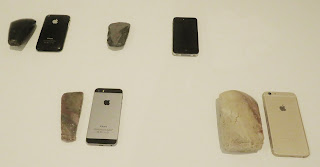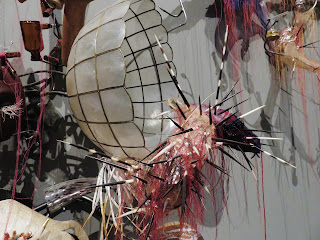In addition to the works of art
at the Giardini and the fiber works in the Arsenale, there were a number of
objects in Viva Arte Viva that I very much enjoyed and that contributed to the
sense of well-being I described in my first post on the Biennale. And, of course, now that I’ve reviewed my
images, there are quite a few. I’ve added some comments on the nonsensical parts
of the label texts, having been a label nut for decades. Relatively short, the object labels offered some
explanatory information, but often they then unfortunately attempted to
philosophize and interpret the works in garbled and frustratingly pretentious
language not unique to this venue, but regrettable.
I rather liked the ecological
works of Michael Blazy (b. 1966 Monaco) and Julian Charriére (b. 1987 Switzerland), but am not reproducing images of
their work. Blazy’s running shoe planters attracted a lot of attention and I found
his brooms planted in the garden and sprouting grasses amusing. Charriére’s
layered white and gray towers somehow referring to the mining and eventual
depletion of lithium were actually lovely.
We watched one complete video,
which probably captured my interest because of my Italian Renaissance sculpture
training. Guan Xiao (b. 1983 China) showed a panoramic array of reproductions
of Michelangelo’s David, so many of them that it became a bit of a test as to
which was the real sculpture, with the final line, “We don’t know how to see
him.” A treasured object is reproduced so often and so badly that few people
actually think about what the original is. It’s an obvious theme, but I
appreciated it. And the video was
lively, short, and to the point.
 I loved the colors of Pénétrable, by Thu Van Tran (b. 1979 Vietnam) - pigmented rubber that coats and penetrates the wall of the gallery - and Au leve au coucher (sunrise to sunset) 2017, three blue-green photograms of plants, including the rubber tree, hung against the peach-tinted wall. Laid on boxes on the floor are red and white sculptures of rubber tree trunks. Sadly, she uses the rubber to symbolize colonialism and abuse of power, as the French imported rubber to Vietnam in the early 20th century and an accompanying video shows people extracting rubber from the trees. Thu Van Tran as an infant became a Vietnamese refugee in France and lives and works in Paris. The didactic information which says, “The artist’s works, offering art as a means of transformation of our determinism due to the history, reveal the shortcomings and irrationality of human nature,” makes no connection to this work as far as I could tell, but then I couldn’t understand it.
I loved the colors of Pénétrable, by Thu Van Tran (b. 1979 Vietnam) - pigmented rubber that coats and penetrates the wall of the gallery - and Au leve au coucher (sunrise to sunset) 2017, three blue-green photograms of plants, including the rubber tree, hung against the peach-tinted wall. Laid on boxes on the floor are red and white sculptures of rubber tree trunks. Sadly, she uses the rubber to symbolize colonialism and abuse of power, as the French imported rubber to Vietnam in the early 20th century and an accompanying video shows people extracting rubber from the trees. Thu Van Tran as an infant became a Vietnamese refugee in France and lives and works in Paris. The didactic information which says, “The artist’s works, offering art as a means of transformation of our determinism due to the history, reveal the shortcomings and irrationality of human nature,” makes no connection to this work as far as I could tell, but then I couldn’t understand it.Yee Sookyung (b. Korea 1963) made a huge sculpture from the pieces of broken Korean ceramics, broken because they came out of the factories with faults and the Korean practice is to destroy faulty pottery. Nine Dragons in Wonderland, 2017 also employs the Asian practice of using gold to mend cracks in pottery, so the castaway parts become a monumental work of art. This is another example of an artist recycling materials, this one especially coherent, monumental and with lovely colors (especially celadon), designs and textures.
Rina Banerjee (b. Calcutta, India 1963, lives in New York) made several flamboyant sculptures that suggest some kind of exotic plants. I thought they were delightful and the long titles seemed consistent with her visionary approach – example: “Addictions to leaf and nut aroused, curled currency and culture to itch and moan as arrivals of plants from plantation, not just servants or slaves exploded, swelled to levels fantastic but without majestic magic hurt to ripen.” These poetic labels suggest feelings and content while the curatorial statement, equally obtuse, “In the sculptures on show, the dialectic between authenticity and transfiguration concerns objects and images, to demonstrate that identity is not authentic if static and unitary, but only if it ‘participates in everything that is in the world,’” is not helpful.

At first Maha Mullah’s (b. 1959 Saudi Arabia) wall work looks like a geometric tile pattern in shades of blue, black and white, then the label identifies the tesserae as audio cassettes made by religious leaders to tell women how to act and the work’s hidden protest becomes clear. Not wanting to fill the world with more stuff, like many other artists, she recycles found objects.
One might walk by Zilia Sanchez’s (b. 1926 Cuba, lives in Puerto Rico), abstract shaped canvases, thinking they are familiar. But she made them in the 1960s when ideas about shaped canvases and the relationship between sculpture and painting was a hot topic. And the white and barely pastel colored pointed shapes have a surprising delicate eroticism.
I also liked Liu Jianhua’s (b. 1962 China) installation of gold glazed porcelain circular forms arranged on black steel rectangles on the Arsenale floor. I was interested that he studied porcelain at the major traditional porcelain center in China, Jingdezhen. As the label indicates, the installation is pure form, suggesting a Buddhist concept of emptiness, “no meaning.” Like a Japanese raked garden, it was precisely conceived and executed and evoked meditative contemplation, a relief in the midst of so much active art.
And finally, one of my favorites, Liliana Porter’s (b. 1941 Argentina, lives in New York), El hombre con el hacha y otras situaciones breves, 2013 (The man with the axe and other brief situations), is full of surprises. At first I saw a bunch of broken furniture and crockery, piled and scattered from a corner, and a large cloud of bluish gauze, another sculpture made of recycled junk, I thought. But near the blue cloud there was a tiny grandmother, knitting the cloud (She's a mere dot in the first photograph). A man was sitting on one of the books, and another stood next to a coffee mug. The man with the axe looked at the whole mess from the side, but others were sweeping up piles of colored powder. The tiny people are of different sizes and occupy some alternate world. It’s fun to explore and it made me reassess my assumptions about the world and remember the importance of looking carefully.
You had to be there to see it in all its charming and amazing details.

















No comments:
Post a Comment